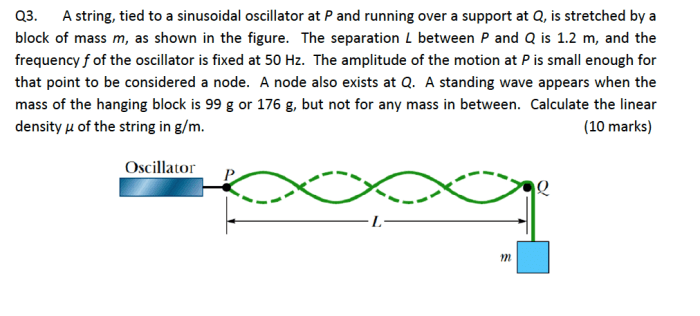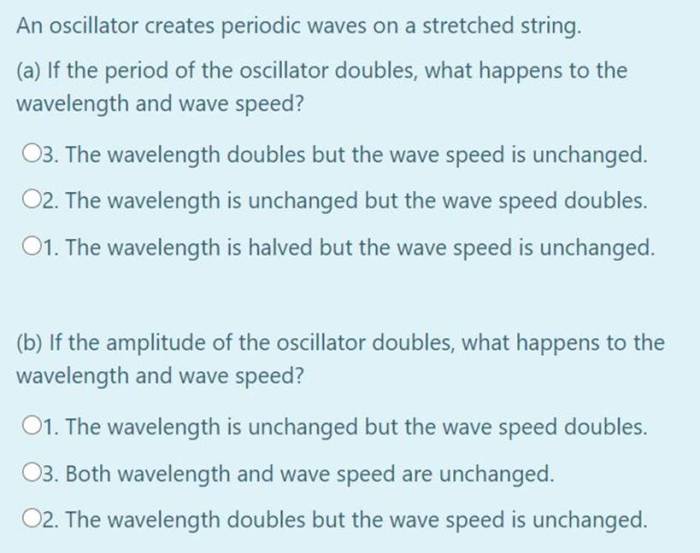An oscillator creates periodic waves on a stretched string. – Oscillators create periodic waves on stretched strings, embarking on a journey through the fascinating world of wave dynamics. This phenomenon finds applications in diverse fields, from musical instruments to telecommunications. Understanding the principles behind these waves empowers us to harness their potential and unlock new technological frontiers.
Delving into the intricacies of oscillators and periodic waves, we uncover the fundamental properties that govern their behavior. From wavelength to frequency, each parameter plays a crucial role in shaping the wave’s characteristics.
1. Oscillators and Their Function

An oscillator is a device that generates periodic waves. It consists of a system that oscillates or vibrates at a specific frequency. Oscillators play a crucial role in creating periodic waves on a stretched string by providing the initial disturbance that sets the string into motion.
Types of Oscillators
- Mechanical oscillators: These oscillators use physical mechanisms, such as springs, pendulums, or vibrating reeds, to generate oscillations.
- Electrical oscillators: These oscillators utilize electronic circuits to generate periodic electrical signals.
- Atomic oscillators: These oscillators use the natural resonant frequencies of atoms to produce highly accurate and stable oscillations.
Principles of Oscillator Design and Operation
The design and operation of oscillators involve understanding the principles of resonance, damping, and feedback. Oscillators are typically designed to operate at a specific resonant frequency, which is determined by the physical properties of the system.
2. Properties of Periodic Waves

Periodic waves are characterized by their repeating pattern over time and space. They are defined by three main properties:
Wavelength
The wavelength (λ) of a periodic wave is the distance between two consecutive crests or troughs.
Frequency
The frequency (f) of a periodic wave is the number of crests or troughs that pass a fixed point per unit time, typically measured in Hertz (Hz).
Amplitude
The amplitude (A) of a periodic wave is the maximum displacement of the wave from its equilibrium position.
Relationship to Oscillator’s Parameters
The properties of periodic waves are directly related to the parameters of the oscillator that generates them. The frequency of the wave corresponds to the frequency of oscillation of the oscillator, while the wavelength and amplitude depend on the physical properties of the medium through which the wave propagates.
3. Wave Propagation on a Stretched String

When an oscillator is attached to a stretched string, it sets the string into vibration, creating periodic waves that propagate along the string.
Factors Affecting Wave Propagation
- Tension: The tension in the string affects the wave’s speed and wavelength.
- Length: The length of the string affects the wavelength and frequency of the wave.
- Material properties: The material properties of the string, such as its density and elasticity, influence the wave’s speed and amplitude.
Influence on Wave’s Speed, Wavelength, and Frequency
The tension in the string affects the speed of the wave, with higher tension resulting in faster wave propagation. The length of the string determines the wavelength, with shorter strings producing shorter wavelengths. The material properties of the string influence the wave’s speed and amplitude.
Examples of Wave Propagation on Different Strings
- Guitar strings: The tension and length of guitar strings can be adjusted to produce different pitches and timbres.
- Violin strings: Violin strings are made of different materials, such as gut, steel, or nylon, which affects their sound quality.
- Piano strings: Piano strings are stretched over a metal frame and tuned to specific frequencies to produce the notes of the piano.
4. Applications of Periodic Waves

Periodic waves have a wide range of applications in science and technology:
Acoustics
- Musical instruments: Periodic waves are used to create sound in musical instruments, such as guitars, violins, and pianos.
- Ultrasound: Periodic waves with high frequencies are used in medical imaging and diagnostics.
Optics
- Lasers: Periodic waves of light are used in lasers to produce coherent and monochromatic beams.
- Optical fibers: Periodic waves are used to transmit light signals through optical fibers for telecommunications.
Telecommunications
- Radio waves: Periodic waves are used to transmit radio signals for communication and broadcasting.
- Microwaves: Periodic waves with higher frequencies are used in microwave ovens and radar systems.
Advantages and Limitations
Periodic waves offer advantages such as precise control over frequency and amplitude. However, they may be susceptible to interference and noise, limiting their applications in certain scenarios.
5. Advanced Concepts
Nonlinear Oscillators
Nonlinear oscillators exhibit complex behavior due to their nonlinear response to external forces. They can produce chaotic oscillations and are used in applications such as secure communications and cryptography.
Chaos
Chaos refers to the unpredictable behavior of nonlinear systems. Chaotic oscillations can be observed in various physical systems, such as weather patterns and fluid dynamics.
Solitons
Solitons are self-reinforcing waves that maintain their shape as they propagate. They have applications in optical communications and signal processing.
Mathematical Models, An oscillator creates periodic waves on a stretched string.
Mathematical models, such as the van der Pol equation and the Lorenz system, are used to describe the behavior of oscillators and periodic waves. These models provide insights into the dynamics and stability of these systems.
Real-World Applications
- Chaotic oscillators are used in secure communication systems to generate unpredictable encryption keys.
- Solitons are used in optical fiber communications to enhance signal transmission efficiency.
FAQ Explained: An Oscillator Creates Periodic Waves On A Stretched String.
What is an oscillator?
An oscillator is a device that generates periodic waves, characterized by their regular pattern and repetition over time.
How does an oscillator create waves on a stretched string?
When an oscillator is attached to a stretched string, it imparts energy to the string, causing it to vibrate and produce periodic waves.
What factors affect the properties of periodic waves?
The properties of periodic waves, such as wavelength and frequency, are influenced by the oscillator’s parameters and the characteristics of the stretched string, including its tension and length.